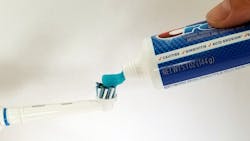Toothpaste matters: The evidence for stannous fluoride
I have never practiced a day without being asked, “What toothpaste should I use?” Patients are constantly overwhelmed by the toothpaste aisle and the products that seem to promise all the same benefits, but with better results than the toothpaste sitting next to it.
A patient’s goals typically include whiter teeth, a healthier smile, and fresh breath. As dental professionals, we must understand the science behind the active ingredients and the challenges of home care and patient compliance that will lead to better health outcomes. Reducing inflammation and bleeding in the mouth will not only benefit the oral health of the patient but also reduce the inflammatory load.
The secret weapon against gingivitis
Daily removal of biofilm is essential in the reduction of gingivitis. We know that our patients don’t brush long enough, often miss areas, and struggle to clean interdentally. This leads to inflammation that is directly induced by the microbial biofilm. We also know that subgingival bacteria thrive in an anaerobic environment and produce bacterial virulence factors (i.e., toxins).1 The byproducts of these toxins trigger an immune inflammatory response that causes further breakdown of periodontal components.
To prevent the negative systemic effects of chronic inflammation, it is essential to prevent the formation and progression of gingivitis. Interdental aids and proper brushing are foundational in the elimination of these destructive biofilms. For the biomass left behind, a toothpaste intervention should be implemented to help restore symbiosis.
According to a meta-analysis published in the Journal of Clinical Periodontology, patients who implement a home care regimen that includes a highly bioavailable stannous fluoride demonstrate a 51% reduction in bleeding when combined with mechanical plaque control above using a sodium fluoride or sodium monofluorophosphate product.2 Let’s look further into what this means.
The value of meta-analysis
A meta-analysis is a statistical procedure for combining data from multiple independent studies. The meta-analysis review is aThe purpose of the meta-analysis
This specific meta-analysis reviewed 18 randomized controlled trials and included 2,890 patients. The aim of the study was to “estimate the gingivitis effects of bioavailable gluconate chelated 0.454% of stannous fluoride (SnF2) family of dentifrices in adult subjects versus positive (triclosan) and negative (NaF or MFP) controls when used < 3 months.”2 The meta-analyses reviewed clinical studies that were three months in duration. The clinical findings were significant in confirming the clinical benefits of stannous fluoride in its ability to reduce gingivitis above other types of fluorides.
What the science has revealed
The results of this meta-analysis demonstrated a reduction in bleeding sites by 51%, and that patients using a manual brush and a well-formulated stannous fluoride dentifrice were 3.7 times more likely to transition to health than those using a standard toothpaste.2
The recommendation of clinically proven ingredients in a toothpaste is a simple way to improve gingivitis (or oral health overall). In fact, patients who brushed with a bioavailable stannous fluoride had similar reductions in bleeding as patients who implemented floss daily for two weeks. Patients typically show a 40% reduction in bleeding when they implement flossing daily.1
The challenges of home care
I ask each of my patients what they are doing for their home-care regimen. If this is my first time with a patient, they are often surprised by the question. They must think about what product is on their bathroom countertop. I often play detective, asking them about the label and the texture of the paste to determine what it is that they are using. In fact, sometimes I can narrow it down by visual clues their mouths are giving me. Often, in my opinion, if a sensitivity toothpaste is used, there tends to be a greater amount of calculus present.
Most patients can’t differentiate between toothpaste types and often underestimate the potential efficacy of ingredients. For example, most patients don’t know there are different types of fluorides in toothpaste, such as stannous fluoride, sodium fluoride, and sodium monofluorophosphate.
One of the easiest things to adapt into the patient’s home-care regimen is a change in toothpaste. One formulation of stannous fluoride has demonstrated the ability to remain active in the reduction of bacteria and their metabolic byproducts (toxins) up to 4 mm below the gumline (Crest Gum Detoxify).3 Additionally, the antibacterial gum protection for 12 hours provides all-day protection for our patients.3
Conclusion
A meta-analysis is considered the highest level of the scientific studies. The evidence demonstrates unequivocal relevance in the efficacy of the stannous fluoride molecules to enable better oral health outcomes. As clinicians, we should expect more for our patients and help guide them toward products that can produce positive oral health outcomes, such as an electric rechargable toothbrush and well-formulated stannous fluoride toothpaste. There are ample benefits to stannous fluoride that make it a simple solution for our patients. Stannous fluoride works to protect against cavities and prevent erosive toothwear, gingivitis, plaque, bad breath, and tooth sensitivity.3
References
- Dahlen G, Basic A, Bylund J. Importance of virulence factors for the persistence of oral bacteria in the inflamed gingival crevice and in the pathogenesis of periodontal disease. J Clin Med. 2019;8(9):1339. doi:10.3390/jcm8091339
- Biesbrock A, He T, DiGennaro J, Zou Y, Ramsey D, Garcia-Godoy F. The effects of bioavailable gluconate chelated stannous fluoride dentifrice on gingival bleeding: meta-analysis of eighteen randomized controlled trials. J Clin Periodontol. 2019;46(12):1205‐1216. doi:10.1111/jcpe.13203
- Klukowska MA, Ramji N, Combs C, et al. Subgingival uptake and retention of stannous fluoride from dentifrice: gingival crevicular fluid concentrations in sulci post-brushing. Am J Dent. 2018;31(4):184‐188.
Editor’s note: This article is sponsored by P&G. Content has been reviewed for editorial integrity per RDH guidelines. For more information on RDH standards of editorial excellence, see rdhmag.com/page/submission-guidelines.
Disclosure: The author has a financial relationship with P&G by providing occasional content.
About the Author

Amber Auger, MPH, RDH
Amber is a dental hygiene clinician, international speaker, and hygiene director who specializes in nonsurgical periodontal therapy, heart-centered education, and efficiency. Through her signature program, Thrive in the OP and Thrive Chairside Summit, she equips hygienists with evidence-based systems to elevate patient outcomes, confidence, and production. Amber blends clinical expertise with practical strategies to help dental teams implement sustainable, science-driven protocols. She can be reached at amberauger.com.


